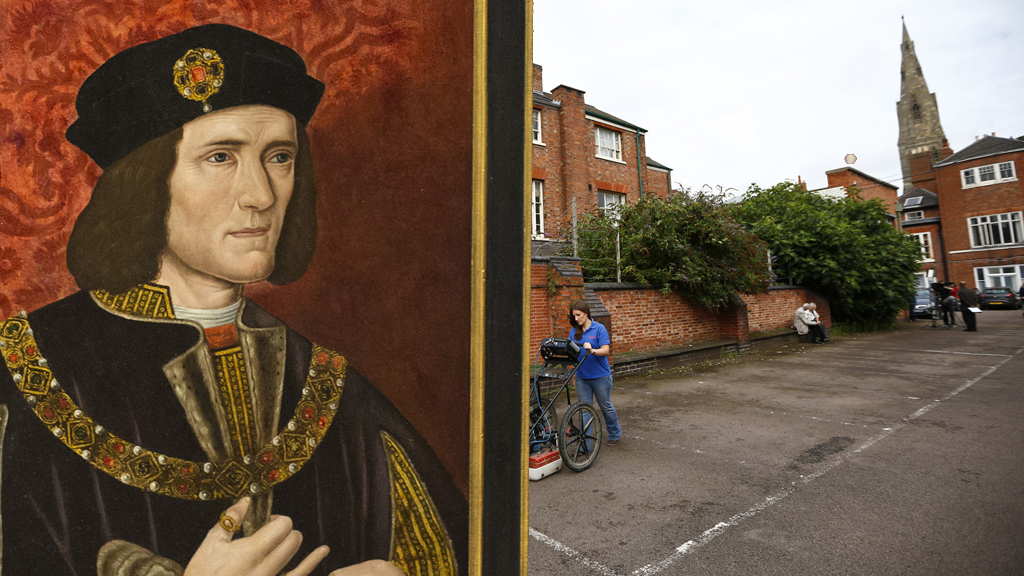Scientists to reveal if Leicester skeleton is Richard III
Scientists are to announce if a skeleton excavated from a Leicester car park is that of Richard III. Asha Tanna explains.

At 10am scientists will announce whether the remains of a skeleton exhumed from under a grey square of tarmac in a Leicester car park is that of Richard III. The results of the dig which took place in September last year could see British history being rewritten.
The body under investigation was pulled from one of three trenches dug across the site after a team of experts from the city’s university began hunting for evidence of where Richard III was believed to have been buried.
If scientific results prove it is the forgotten monarch, it could be one of the century’s biggest British archaeological discoveries.
Body under tarmac
The project, part funded by the Richard III Society, was accepted by Leicester University’s archaeology department on the grounds that they might be able to locate the boundaries of the lost Franciscan Greyfriars Church, his last known resting place.
The search at the municipal car park turned up traces of a building, and then something incredibly exciting: an entombed human skeleton, complete with evidence of battle wounds – a blow to the head, and an arrow in the back – and scoliosis, or curvature of the spine.
The remains were also in surprising good condition given the fact they were buried in a simple shroud without a coffin to protect them. But with scientific proof, the discovery was just speculative.
Genetic evidence
Over the last few months the scientific team has been in lock-down ahead of Monday’s announcement. Hours have been spent in the labs analysing the remains using the latest technology – radiocarbon dating; facial reconstruction and a DNA test with, amazingly, a 17th generation descendant from Richard’s sister, Anne of York.
The descendent is a Canadian-born carpenter now living in Paddington, Michael Ibsen. With just one saliva swab Mr Ibsen has found himself at the centre of a historic media frenzy.
According to genealogical records, experts say Mr Ibsen should share the king’s “haplotype” or genetic sub-group. If Mr Ibsen’s haplotype is rare – and matches the medieval remains – it may confirm that the body is that of the king.
Tainted name?
Later tonight a film-length Channel 4 documentary: Richard III: The King in the Car Park will be screened and follows the discovery and analysis through every painstaking moment including this morning’s long awaited moment.
There is much debate surrounding the 15th Century “hunchback” monarch and opinion remains divided. Some have portrayed him as a complex Machiavellian character accused of killing his own nephews the “Princes in the Tower” to claim the throne.
Devotees on the other hand dispute that he was a power-crazed tyrant and argue he was brave and enlightened.
Records suggest that in August 1485, Richard – the last Plantagenet English king to die in battle – rode out from Leicester wearing his armour of burnished steel to the Battle of Bosworth Field.
Shakespeare portrayed him shouting, “A horse! A horse! My kingdom for a horse!” when fighting for his crown. His death marked the end of a 30-year bloody civil war and dynastic struggled known as the War of the Roses.
While other monarchs might have received the pomp and ceremony of a state funeral, as a defeated warrior, Richard III did not. Instead the medieval king’s body was stripped naked and tied over the back of a horse. His corpse was ignominiously taken back to Leicester, en route his head struck a stone and broke it open. The bloody corpse was then hastily buried in a nearby church.
The lost grave of Richard III has caught the world’s imagination and there’s great anticipation over this incredibly discovery and what follows next. Should the DNA results prove the remains do belong to him yet another, but less gruesome battle, can be expected. This time over where the forgotten king should be laid to rest.
-
Latest news
-
‘Russian aggressions have never pushed Georgia to deviate from its own path’, says Georgian President5m

-
Why is Georgia’s ruling party so intent on adopting ‘foreign influence’ bill?5m

-
Trump’s lawyers try to paint Michael Cohen as liar out for revenge at trial3m

-
England’s schools told not teach gender identity2m

-
Slovakia PM shooting: Suspect charged with attempted murder3m

-




